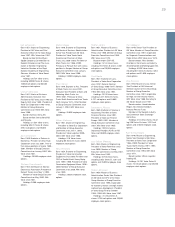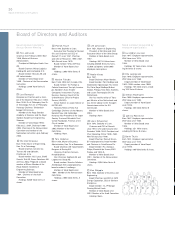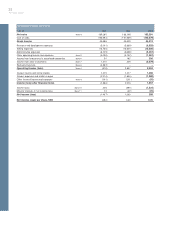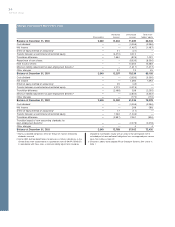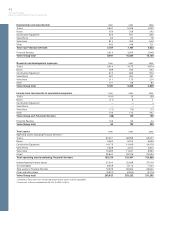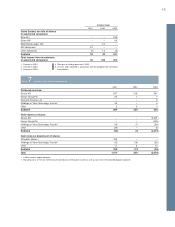Volvo 2003 Annual Report Download - page 40
Download and view the complete annual report
Please find page 40 of the 2003 Volvo annual report below. You can navigate through the pages in the report by either clicking on the pages listed below, or by using the keyword search tool below to find specific information within the annual report.
38
The Volvo Group
Notes to consolidated financial statements
Interest-rate contracts that do not fullfil the criteria of hedge
accounting are valued at the balance sheet date at which time provi-
sions for unrealized losses are made.
Net sales
The Group’s reported net sales pertain mainly to revenues from sales
of goods and services. Net sales are reduced by the value of dis-
counts granted and by returns.
Income from the sale of goods is recognized when significant
risks and rewards of ownership have been transferred to external
parties, normally when the goods are delivered to the customers. If,
however, the sale of goods is combined with a buy-back agreement
or a residual value guarantee, the sale is accounted for as an operat-
ing lease transaction if significant risks of the goods are retained in
Volvo. Income from the sale of workshop services is recognized
when the service is provided. Rental revenues and interest income in
conjunction with financial leasing or installment contracts are recog-
nized over the contract period.
Research and development expenses
Effective in 2001, Volvo adopted RR 15 Intangible Assets. In accord-
ance with the new accounting standard, expenditures for develop-
ment of new products, production systems and software shall be
reported as intangible assets if such expenditures with a high degree
of certainty will result in future financial benefits for the company.
The acquisition value for such intangible assets shall be amortized
over the estimated useful life of the assets. Volvo’s application of the
new rules means that high demands are established in order for these
development expenditures to be reported as assets. For example, it
must be possible to prove the technical functionality of a new prod-
uct or software prior to this development being reported as an asset.
In normal cases, this means that expenditures are capitalized only
during the industrialization phase of a product development project.
Other research and development expenses are charged to income as
incurred. Expenditures for development of new products, production
systems and software before 2001 was expensed as incurred and in
accordance with the transition rules no retroactive application of RR
15 was made.
Warranty expenses
Estimated costs for product warranties are charged to operating
expenses when the products are sold. Estimated costs include both
expected contractual warranty obligations as well as expected good-
will warranty obligations. Estimated costs are determined based upon
historical statistics with consideration of known changes in product
quality, repair costs or similar. Costs for campaigns in connection
with specific quality problems are charged to operating expenses
when the campaign is decided and announced.
Restructuring costs
Restructuring costs are reported as a separate line item in the income
statement if they relate to a considerable change of the Group struc-
ture. Other restructuring costs are included in Other operating in-
come and expenses. A provision for decided restructuring measures
is reported when a detailed plan for the implementation of the meas-
ures is complete and when this plan is communicated to those who
are affected.
Depreciation, amortization and impairments of tangible and
intangible non-current assets
Depreciation is based on the historical cost of the assets, adjusted in
appropriate cases by write-downs, and estimated useful lives.
Capitalized type-specific tools are generally depreciated over 2 to 8
years. The depreciation period for assets under operating leases is
normally 3 to 5 years. Machinery is generally depreciated over 5 to
20 years, and buildings over 25 to 50 years, while the greater part of
land improvements are depreciated over 20 years. In connection with
its participation in aircraft engine projects with other companies,
Volvo Aero in certain cases pays an entrance fee. These entrance
fees are capitalized and amortized over 5 to 10 years. Product and
software development is normally amortized over 3 to 8 years.
The difference between depreciation noted above and deprecia-
tion allowable for tax purposes is reported by the parent company
and in the individual Group companies as accumulated accelerated
depreciation, which is included in untaxed reserves. Consolidated
reporting of these items is described below under the heading
Deferred taxes, allocations and untaxed reserves.
Goodwill is included in intangible assets and amortized over its
estimated useful life. The amortization period is 5 to 20 years. The
goodwill amounts pertaining to Renault Trucks, Mack Trucks, Volvo
Construction Equipment, Champion Road Machinery, Volvo Aero
Services, Prévost, Nova BUS, Volvo Bus de Mexico, Volvo Construc-
tion Equipment Korea, Volvo Aero Norge and Kommersiella Fordon
Europa are being amortized over 20 years due to the holdings’ long-
term and strategic importance.
If, at a balance sheet date, there is an indication that a tangible or
intangible non-current asset has been impaired, the recoverable
amount of the asset is estimated. If the recoverable amount is less
than the carrying amount, an impairment loss is recognized and the
carrying amount of the asset is reduced to the recoverable amount.
Inventories
Inventories are stated at the lower of cost, in accordance with the
first-in, first-out method (FIFO), or net realizable value.
Liquid funds
Liquid funds include cash and bank balances and marketable securi-
ties. Marketable securities are stated at the lower of cost or market
value in accordance with the portfolio method. Marketable securities
consist of interest-bearing securities, to some extent with maturities
exceeding three months. However, these securities have high liquidity
and can easily be converted to cash.
Post-employment benefits
Effective in 2003, Volvo has adopted RR 29 Employee benefits in
accounting for post-employment benefits (see “Changes of account-
ing principles in 2003”). In accordance with RR 29, actuarial calcula-
tions under the projected unit credit method should be made for all
defined benefit plans in order to determine the present value of obli-
gations for benefits vested by its current and former employees. The
actuarial calculations are being prepared annually and are based
upon actuarial assumptions that are determined close to the balance
sheet date each year. Changes in the present value of obligations
due to revised actuarial assumptions are treated as actuarial gains or
losses which are amortized over the employees’ average remaining
service period to the extent these exceed the corridor value for each
plan. Deviations between expected return on plan assets and actual
return are treated as actuarial gains or losses. Provisions for post-
employment benefits in Volvo’s balance sheet correspond to the
present value of obligations at year-end, less fair value of plan
assets, unrecognized actuarial gains or losses and unrecognized
unvested past service costs. Up to and including 2002, defined ben-
efit plans were accounted for in accordance with local rules and
directives in the respective country of Volvo’s subsidiaries. For post-
employment benefits that are financed through defined contribution
plans, Volvo’s annual contributions to such plans are expensed as
incurred. The accounting for defined contribution plans has not been
affected by the adoption of RR 29 in 2003.



